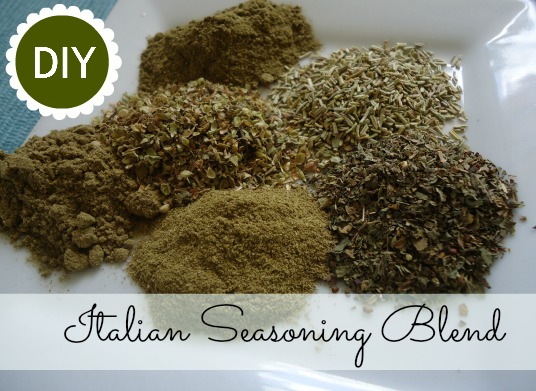Make Your Own Italian Seasoning Blend
Sometimes I think you can tell a woman’s age by the color of her Tupperware and the number of spices she has lingering about in her cupboard.
I have some harvest gold Tupperware and neglected bottles of Herbs de Provence and Fennel Seed. ’nuff said
This week however, I put my stash of spices to good use and made my own Italian Seasoning blend.
Italian seasoning blends will almost always be some combination of these six spices: Oregano, Basil, Rosemary, Sage, Thyme, and Marjoram. The starting point for making your own blend is usually to just stir together equal amounts of each of those spices.
Of course the great part about making your own homemade Italian seasoning blend is that you’re free to make as much or as little as you want, and you can adjust the amounts of the spices to suit your taste. I started off with just a small batch and made it a little heavier on the oregano (because that’s one of my favorite spices) and a little lighter on the marjoram (because that spice is kind of “earthy”). Another option, which I chose not to do, is to stretch this recipe a little further by adding a teaspoon or two of dried parsley.
Here’s my recipe:
Italian Seasoning Blend
You Will Need:
- 1-1/2 tsp Dried Oregano
- 1 tsp Dried Basil
- 1 tsp Dried Crushed Rosemary
- 1 tsp Ground Sage
- 1 tsp Ground Thyme
- 1/2 tsp Ground Marjoram

And if you remember from my last post about my Homemade Goo Gone, I cleaned up and repurposed a little jar that used to hold chicken bouillon powder and it’s working great for my new spice blend!
Need Some Ideas for Using Italian Seasoning?
One of the ways I like to use Italian seasoning is in my Herb Butter recipe that I use to spice up steamed or baked fish (Yum!)
I also use it in this tasty casserole dish that uses ground turkey.
Ground Turkey Noodle Bake
Adapted from All Recipes
- 3 cups (measure when uncooked) wide egg noodles
- 1 Lb ground turkey
- 1/4 cup minced onion
- 2 – 8 oz cans tomato sauce
- 1-1/2 teaspoons Italian seasoning
- 1/2 cup milk
- 4 ozs cream cheese
- 1 teaspoon dried parsley
- 1 clove garlic, minced
- 1-1/4 cups shredded mozzerella cheese
Bring a pot of water to a boil and cook the egg noodles (approximately 7 minutes). Drain.
Meanwhile, in a skillet, cook the onion and the ground turkey until the turkey is no longer pink. Drain any grease, although turkey is a lean meat and you probably won’t even have any grease in your skillet.
Add the tomato sauce and Italian seasoning to the skillet and bring to a boil. Then let simmer while you make the cream cheese sauce.
In a small saucepan, combine the milk, cream cheese, parsley, and minced garlic and heat until the cream cheese is melted.
Toss the noodles with the cream cheese mixture and transfer to a greased 8″ square dish (or I used a 11×7 rectangle pan). Top with the turkey mixture and then sprinkle with the shredded mozzerella.
Bake at 350 degrees for 30 minutes.
And while we’re on the subject of spices – here’s one of my previous posts about My Top 10 Spices which also takes a look at my frugal solution for a spice bottle organizer.




I realize this is an old post but I’m hoping to still get an answer. When you say “sage” what form do you use? I have read several Italian seasoning recipes and no one specifies. When I was in the store wanting to buy some “sage” I found several types and didn’t know which to buy. I can’t find an answer anywhere. Is it “ground”, “dried”, “rubbed”? Some of them said “sage leaves” others just said “sage”. Any advice on what to buy would be appreciated! Thanks!
The two types of sage I keep in my spice rack are the ground sage and the rubbed sage. The ground sage is very powdery while the rubbed sage is a little coarser with larger pieces of the herb still visible.
If I’m using sage in a spice blend I usually use the ground sage because I think the finer, more powdery texture blends in a little better. Ground sage is what I used in this homemade Italian spice blend. The main thing I use the rubbed sage for is in one of my flavored rice recipes. I’m still trying to decide if the ground sage is just a little bit stronger than the rubbed sage. Sometimes I use just a little bit less than is called for in a recipe if I’m using the ground sage.
So my experience has been that it doesn’t make too much of a difference which type of sage you use. The textures are a little different but they’ll both deliver the flavor of sage to a recipe.